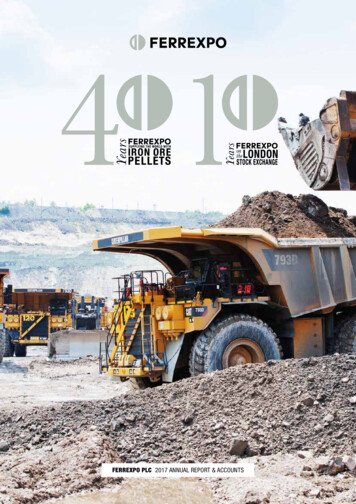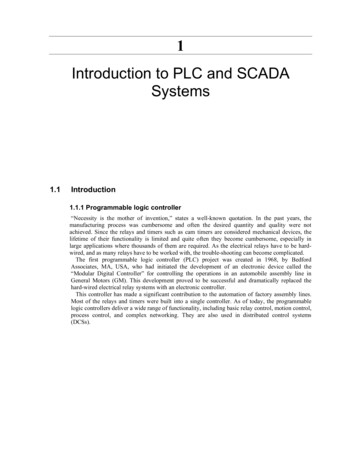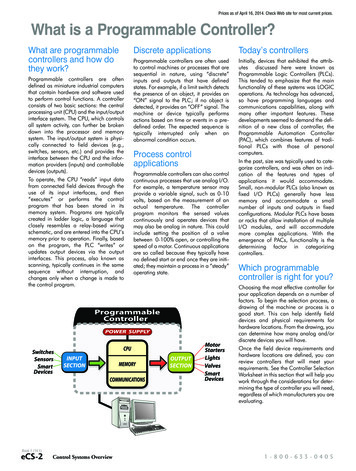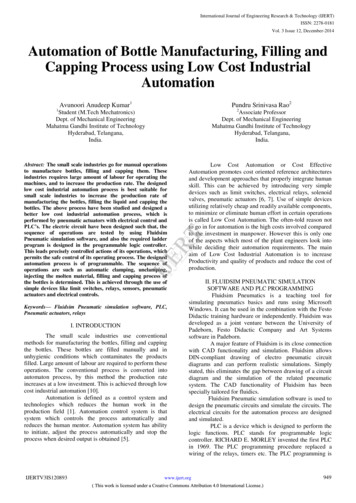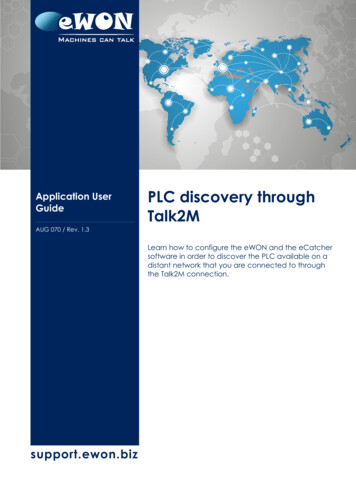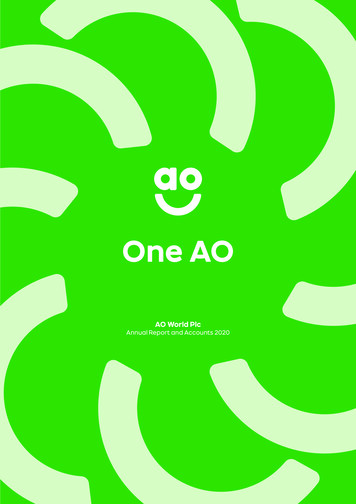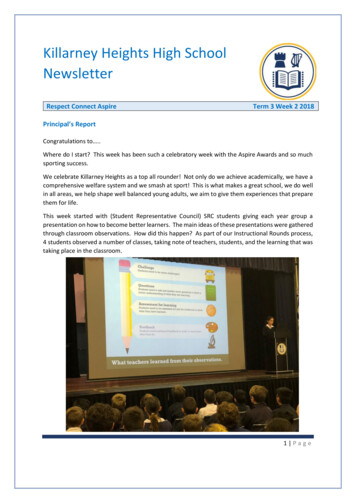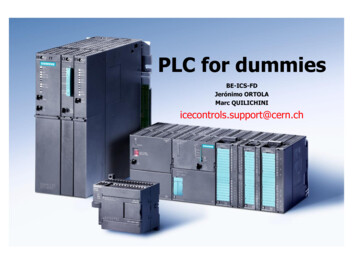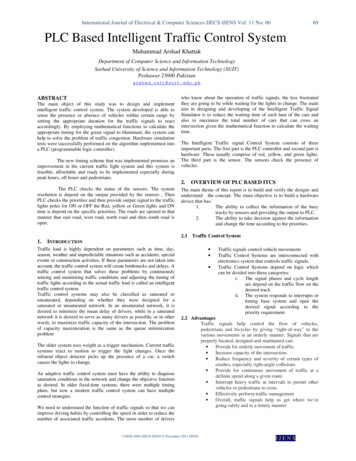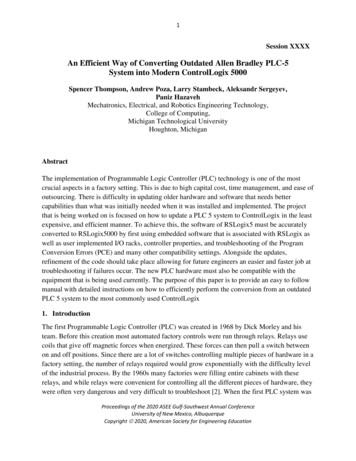
Transcription
5 August 2020Ferrexpo plc(“Ferrexpo”, the “Group” or the “Company”)Ferrexpo delivers increased sales and production volumes, resilient financial performance and strengthened balancesheet in 1H 2020, despite unprecedented global disruption.Ferrexpo plc today announces its unaudited financial results for the six months ended 30 June 2020.Financial Highlights Pellet production and sales volumes up 5% and 22% respectively Revenues of US 776 million (1H 2019: US 787 million) reflecting lower pellet premiums Underlying EBITDAA US 352 million (1H 2019: US 372 million) EBITDA margin 45% (1H 2019: 47%) Profit after tax of US 250 million (1H 2019: US 270 million) Interim dividend declared of 6.6 US cents (1H 2019: 6.6 US cents), in addition to an interim dividend of 6.6 US cents pershare declared in June 2020 Net debt A US 174 million (31 December 2019: US 282 million) Net debt A to last twelve months’ EBITDA ratio down to 0.31x, compared to 0.48x at 31 December 2019 Capital investment US 96 million (1H 2019: US 114 million)Steve Lucas, Non-Executive Chairman, said:“I am pleased to report a positive set of results for the half year, with strong cash generation, higher sales and production, lowerC1 costs and debt, and solid EBITDA of US 352 million, all in the context of a pandemic that has disrupted the global economy.That is a testament to our strong management team and the commitment of our entire workforce.The Company has approached the uncertainty of current global events with caution, destocking throughout the period and hasreduced net debt to US 174 million and increased cash to US 169 million as at 30 June 2020. The operations are now benefitingfrom the refurbishment work completed in 2019 and first half production was the second highest since IPO in 2007. This positiveoperational and financial performance has enabled the Group to declare an interim dividend to shareholders in June, and in lightof the strong liquidity position the Group is pleased to declare today a further interim dividend of 6.6 US cents per share. Ferrexpohas continued its investment for growth in the first half year and aims to double output from the Group’s operations in Ukraine overthe medium term.Whilst the ongoing global COVID-19 pandemic has affected demand in most markets, Ferrexpo’s operations continue to operatewith minimal disruption. The Group has adapted to a changing market environment, and has sold increased volumes to Chinawhere demand remains robust. As the market returns to more normal conditions in 2H 2020, we expect to see a recovery in steeldemand outside China, which should be constructive for pellet premiums.”Financial Summary:US million (unless otherwise stated)Total pellet production (kt)Sales volumes (kt)Avg PLATTS CFR 62% Fe iron ore fines price (US /t)Avg PLATTS CFR 65% Fe iron ore fines price (US /t)RevenueAverage C1 cash costA (US /t)Underlying EBITDAAUnderlying EBITDA marginAProfit after tax for the periodDiluted EPS (US cents)Interim dividends per share declared (US cents)Net cash flow from operating activitiesCapital investmentAClosing net debtClosing cashNet debt to last twelve months' EBITDA A6 %25042.413.2258961741690.31x6 %27045.86.6256114282920.44xChange5%22%-0.3% 68.413.24732472811310.48x1
Health and Safety No work related fatalities in 1H 2020 (FY 2019: none) Group Lost Time Injury Frequency Rate remains below 1.0x, with a ratio of 0.77x recorded for 1H 2020 (FY 2019: 0.58,1H 2019: 0.45). COVID-19 update: the Group’s facilities continue to operate with minimal impact on operations to date, and the Groupcontinues to closely monitor its workforce. The infection rate in the local communities surrounding the Group’s operationsremains low.Market Environment Average iron ore price (65% Fe) remained above US 100 per tonne. The global pellet market faced reduced demand in 1H 2020 due to lower steel production in regions other than China,however, this was partly mitigated by significantly lower pellet supply from Brazil. Average realised FOB price decreased 13% compared to record prices seen during 1H 2019. This was primarily due tolower pellet premiums. Realised prices were 7% above the level seen during 2H 2019. C3 freight rate fell US 2 per tonne to US 13 per tonne as a result of lower oil prices and a reduction in Brazilian iron oresupplyOperational Highlights 5% increase in pellet production compared to 1H 2019 22% increase in sales volumes compared to 1H 2019 Increased spot sales to China in response to reduced pellet demand in traditional markets C1 cash cost US 41 per tonne, down 11% compared to 1H 2019, reflecting lower commodity prices and increasedproduction. Capital investmentA US 96 million (1H 2019: US 114 million) as pellet line refurbishment programme comes to a closeand investment in concentrator expansion is completed Two trial cargoes of DR pellets sold in 1H 2020, totaling a combined 185kt Plant capacity expected to increase to 12 million tonnes of pellets in 2021Board of Directors and Corporate Governance Appointment of Jim North as Acting CEO and as a Director of the Company Non-executive Chairman Steve Lucas to retire ahead of Group’s next AGM once an orderly succession process has beenput in place Process underway to appoint additional Independent Non-executive DirectorsEnvironment, Social and Governance (“ESG”) Release of Company’s Responsible Business Report on Company’s website, covering ESG activities in 20192
ALTERNATIVE PERFORMANCE MEASURESWords with the symbol A are defined in the Alternative Performance Measures section on pages 35 and 36.Analyst conference call and webcastFerrexpo will host an analyst presentation today via audio webcast which will start at 09:00 BST.To join the webcast, and view the live presentation, please follow this link https://edge.media-server.com/mmc/p/4xohmjag.If you wish to join this conference call, please see following dial in details and instructions:1. 10 minutes prior to the start of the call, dial the appropriate Participant Dial-In Number listed in the Conference Dial-In Numbersection below.2. Enter the Event Plus Passcode stated below and leave any information requested after the tone. You will be joinedautomatically to the conference.Note: Due to regional restrictions some participants may receive Operator assistance when joining this conference call and will not beautomatically connected.Event Plus Passcode:359 2014Participant Standard International Dial-In: 44 (0) 20 3009 5709Participant UK Local Call Dial-In Number:0800 694 1461For further information, please contact:Ferrexpo:Rob Simmons 44 207 389 8305Maitland:James Isola 44 207 379 5151Notes to Editors:Ferrexpo is a Swiss headquartered iron ore company with assets in Ukraine. It has been mining, processing and selling high qualityiron ore pellets to the global steel industry for over 40 years. In 2019, the Group produced 10.5 million tonnes of pellets ranking itas the 3rd largest exporter of pellets to the global steel industry with a market share of approximately 8%. Ferrexpo has a diversifiedcustomer base supplying premium steel mills in Austria, Germany, Japan, South Korea, Taiwan, China, Slovakia, the CzechRepublic, Turkey, Vietnam and America. Ferrexpo has a premium listing on the main market of the London Stock Exchange underthe ticker FXPO. For further information, please visit www.ferrexpo.com3
IntroductionGood progress continues to be made in safe working, with no work related fatalities in 1H 2020 (1H 2019: none). The lost time injuryfrequency rate (“LTIFR”) remains below 1.0x (1H 2020: 0.77x, 1H 2019: 0.45x), representing a further improvement compared to theGroup’s five-year average LTIFR of 1.01x.The Group continues to operate with minimal impact from the global COVID-19 pandemic, with measures put in place in March 2020to protect our workforce and insulate the Group’s ability to continue production in the event of infections occurring locally at any ofour operations. Measures put in place in March include administrative staff working from home, minimising contractor operations andthe downsizing of individual teams in operating areas to allow for social distancing and the option to switch teams should one teamneed to go into isolation. The Group continues to monitor infection rates in all geographic locations in which it operates, and has amitigation plan in place that is specific for each geographic location.Pellet production rose 5% in 1H 2020 to 5.6 million tonnes, representing the second highest production volume for the first half sincethe Group listed in 2007, and the highest first half volume produced since 2016. Despite rising production, Group revenues fell 1%during the period due to lower realised prices, which were the result of lower pellet premiums. For more information, please seesection titled Iron Ore Market Review (Iron Ore Pricing). The Group continues to generate strong cash flows and profit after tax in1H 2020 was US 250 million, a decrease of 8% on 1H 2019 reflecting lower pellet premiums.1H 2020 showed stable iron ore prices as demand in China remained robust, with the Platts iron ore price (65% Fe) starting theperiod at US 104 per tonne, and finishing the period US 10 per tonne higher, with an average of US 106 per tonne. 99% ofFerrexpo’s pellets sold were pellets grading 65% Fe, or above (1H 2019: 96%).For 50 years, Ferrexpo has produced iron ore pellets for the global steel sector, as this form of iron ore allows for reduced energyinputs, slag volumes and carbon dioxide emissions. Independent research by CRU suggests that for each tonne of Ferrexpo pelletsutilised by steel mills instead of sinter, this reduces the mill’s carbon dioxide emissions by 40%. As a result of the favourablecharacteristics of iron ore pellets over other forms of iron ore such as sinter fines, pellets receive a premium. This pellet premiumaveraged US 30 per tonne in 1H 2020, falling from US 67 per tonne in 1H 2019 due to changing market dynamics in 2020 relatingto the global COVID-19 pandemic. For more information, please see section titled Financial Review.The Group expects to begin commissioning its latest concentrator expansion in 2H 2020, which will increase its run of mine oreprocessing capacity by approximately 6 million tonnes per annum, and enable the Company to fully utilise its existing installedpelletiser capacity of 12 million tonnes per annum in 2021. For more information, please see Capital Investment section.The Group is committed to maintaining low net debt and paying dividends to shareholders (see Dividends section). Capital allocatedto investment will be for incremental high IRR projects with the goal of sustainably increasing output to approximately 20 million tonnesover the medium term.DividendsThe Group has reduced gross debt to US 343 million and increased cash to US 169 million. As a result of the strong cash flow andresulting liquidity position, the Group is pleased to announce a further interim dividend of 6.6 US cents per Ordinary Share payableon 26 August 2020 to shareholders on the register at the close of business on 14 August 2020. The ex-dividend date will be 13August 2020. All dividends are paid in UK Pounds Sterling, with an election to receive in US Dollars.On 15 June 2020, the Directors declared an interim dividend of 6.6 US cents per Ordinary Share.Board Membership and Corporate GovernanceThe Board of Ferrexpo remains committed to maintaining strong levels of corporate governance practices and transparencythroughout the Group.During the period, it was announced following the Company’s annual general meeting (“AGM”) in May 2020 that Steve Lucas,Chairman of the Board, has decided to retire as Chairman and resign from the Board once an orderly succession process has beenput in place. In any event, it is envisaged that Steve will not stand for re-election at the Company’s next AGM.4
Since the end of the period, it was announced on 6 July 2020, that Chris Mawe, Chief Financial Officer (“CFO”), would vacate hisrole as a Director of the Company. In addition, the Group announces today that Chris Mawe is stepping down from his role as CFO,with Roman Palyvoda assuming the role of Acting CFO until further notice. As a result, the Board has begun a formal process toidentify and appoint a successor.Jim North, Acting Chief Executive Officer (“Acting CEO”), joined the Board on 6 July 2020. In compliance with the UK CorporateGovernance Code, at least half of the Board (excluding the Chairman) are Independent Non-executive Directors.As noted in the Company’s 2019 Annual Report and Accounts, the Nominations Committee is already seeking to make a furtherappointment of a suitable Independent Non-executive Director to strengthen the Board and relevant Board Committees. An additionalprocess to appoint a further new Independent Non-executive Director and to appoint a new Chairman has commenced and is beingled by the Nominations Committee.FPM Share Transfer RestrictionOn 3 June 2020, the Group advised that the restriction placed on the transfer of certain shares in Ferrexpo Poltava Mining (“FPM”)held by Ferrexpo AG Switzerland, the sole shareholder in FPM, had been cancelled following an appeal by the Group. On 19 June2020, the Group advised that a new restriction had been placed on the same shares in FPM that are held by Ferrexpo AGSwitzerland. For further information see Note 17 Commitments, contingencies and legal disputes.Iron Ore Market ReviewIron Ore PricingDuring 1H 2020, the iron ore price remained relatively stable, despite uncertainty relating to the global COVID-19 pandemic, with thePlatts 65% Fe iron ore index rising during the period by 9% to US 114 per tonne as of 30 June 2020, and averaging US 106 pertonne throughout the half year period. This average is in line with the average Platts iron ore price (65% Fe) seen 1H 2019, whichaveraged US 105 per tonne. Contributing factors behind the relative stability in the iron ore price in 1H 2020 included significant ironore supply disruptions out of Brazil which counter balanced a reduction in steel production related to the ongoing global COVID-19pandemic and associated economic slowdown. High grade premiums, defined as the difference between the 62% Fe Index and the65% Fe Index, and which represent the price paid for the additional ferrum and lower impurities in high grade ores, averaged US 15per tonne in 1H 2020 (1H 2019: US 14 per tonne).1H 2019 was notable for record high pellet premiums in addition to strong iron ore prices following a major disruption to the supplyof Brazilian iron ore in early 2019. These record pellet premiums tailed off in 2H 2019 as the market rebalanced and steel demandweakened. During 1H 2020, pellet premiums continued to fall gradually throughout the period. Lower freight rates, due to reducedshipping from Brazil and falling global oil prices, offset much of the fall in pellet premiums throughout1H 2020.FreightThe C3 freight rate, which is principally used as a freight reference in the pricing of the Group’s sales contracts, was on averageUS 13 per tonne in 1H 2020 (1H 2019: US 15 per tonne), reflecting lower iron ore volumes out of Brazil and lower oil prices duringthe period.Iron Ore SupplyBased on quarterly data from Ferrexpo’s peers, Brazilian iron ore export volumes fell by more than 15% in 1H 2020 compared to 2H2019 whilst Australian iron ore shipments from the Pilbara, accounting for the majority of seaborne shipments into China, exportedsimilar iron ore volumes in 1H 2020 compared to 2H 2019. However, compared to output from the Pilbara in 1H 2019, which wasaffected by tropical cyclones, company data suggests that production in 1H 2020 was up by approximately 3% year on year. Thesupply disruption of Brazilian iron ore has helped support iron ore prices despite reduced steel demand during the COVID-19pandemic.Published data by MySteel 1 shows that stockpiles of imported iron ore at Chinese ports was c.108 million tonnes at the end of 1H2020, compared to c.125 million tonnes of iron ore at the start of the period, implying a drawdown of iron ore inventories during 1H2020 of c.17 million tonnes. This inventory level is equivalent to 37 days of Chinese steel production 2 which is historically low steel-raw-materials/1.htmlUsing CRU estimate of Chinese steel production in 2019 of 977 million tonnes.5
has also served to support iron ore prices during 1H 2020.Conversely, stocks of imported iron ore pellets at Chinese ports, which are included in the total inventory figures, rose from c.5 milliontonnes at the start of 1H 2020 to c.9 million tonnes as of the end of the period 3, a significant increase and a record level comparedto previous periods. The higher iron ore pellet inventories in China are attributable to increased pellet production by exporters fromCanada, Ukraine, Sweden and Russia in 1H 2020, whilst weaker demand for pellets from traditional markets in Europe and Japanthat has resulted in increased shipments to the Chinese market. This has resulted in a decrease in the average published Platts CFRChina 62% Fe spot pellet premium assessment from US 33 per tonne in 1H 2019 to US 27 per tonne in 1H 2020.Iron Ore Pellet SupplyGlobal seaborne pellet supply was up by approximately 4.0 million tonnes in 1H 2020 compared to 1H 2019 4, with this small overallincrease largely attributable to strong operational performance and destocking by pellet exporters in Canada, Sweden, Russia, Chileand Ukraine. However, these gains have been partially counterbalanced by underperformance in Brazilian pellet supply. Theincreases in output seen from producers during 1H 2020 are not expected to continue into 2H 2020, however, with some producersannouncing plans to supply more concentrate and less pellets to the market until pellet premiums recover, whilst supply constraintsin Brazil are expected to continue. As the global economy recovers after the COVID-19 pandemic, the Group expects to see higherpellet premiums toward the end of the calendar year.Iron Ore Pellet DemandAccording to the World Steel Association, global crude steel production fell in 1H 2020 by 6% to 873 million tonnes. The year startedwith the first two months ahead of the corresponding period in 2019, however, each month since March 2020 has seen a 5-15% yearon year decline in output. China’s steel output, which accounts for approximately 60% of global steel production, achieved recordlevels of production in May and June, having previously seen a decrease in output in March. The EU and Japan, which account for8% and 5% of global steel production respectively, have seen steeper declines in steel production in 2Q 2020, with both regionsreporting year on year steel output dipping by between 20% and 40% in April, May and June.Overall, the World Steel Association expects global steel production to contract by 6% in 2020, followed by a 4% recovery to 1,717million tonnes in 2021, as the global economy recovers from the current COVID-19 crisis.Regional changes in the global demand for steel are influencing the regional demand for iron ore pellets and pellet premiums. Withsteel production in China now returning to 2019 levels or above, pellet demand from Chinese steel producers has increased, withglobal pellet imports up more than 10.0 million tonnes in 1H 2020 to c.17.5 million tonnes. The Group expects that demand for pelletsin China will continue to increase over the longer term as pollution controls are implemented across Chinese cities, and Chinesesteel mills transition from lower grade, higher impurity sources of iron ore and toward higher grade feed stocks including iron orepellets.In 2Q 2020, the World Steel Association reported that steel production in both the EU and Japan was around 30% below the levelseen 12 months ago, with pellet demand decreasing by approximately 1.5 million tonnes in the EU in 1H 2020. A similar fall in pelletdemand has occurred in Far East Asia (excluding China) and South East Asia combined. Looking ahead, increasing activity in theautomotive and construction sectors in the EU and Asia suggests that steel demand is set to increase in 2H 2020. The Grouptherefore expects that pellet demand from these regions will gradually recover to normal levels over the course of 2H 2020.In the longer term, the Group expects that tighter emissions controls and regulation, particularly in the EU, will result in additionaldemand for high grade, low impurity pellets in the future. Independent research by CRU has demonstrated the advantage of lowerCO2 emissions from using additional pellets in the blast furnace burden instead of sinter fines, primarily the result of steel producersnot required to sinter material before it enters the blast furnace. This research estimates that steel mills produce approximately 40%less CO2 for each tonne of pellet used in place of sinter fines.Ferrexpo Pellet SupplyDespite recent weakness in pellet demand in markets other than China and falling pellet premiums, the fundamental arguments forsteelmakers to use Ferrexpo’s high grade, low impurity iron ore pellets remain, with increasing demand for raw materials that reduceenergy input requirements, slag volumes and CO2 emissions in the steelmaking process while also improving the quality of the finalproduct. Increasing environmental awareness in China is of particular significance due to this market consuming an additional 1520% of the seaborne traded pellet volume in 1H 2020, suggesting that if this demand is maintained, it will provide support to pellet34Source: MySteelManagement estimate6
premiums as demand in Europe and the rest of Asia returns.The Group benefits from having a geographically diverse portfolio of customers, with Ferrexpo’s load port in Ukraine well positionedto supply steel producers in Europe, North East Asia, North America, Middle East and China. At current production volumes, theGroup is not constrained by logistics and can supply the various markets as required. In 1H 2020, the Group redirected sales towardsChina, as a result of increased pellet demand in China and weakness in the European market. As a proportion of the sales portfolio,China increased from 25% in 2019 to 66% in 1H 2020. The Group expects that this trend will reverse in 2H 2020, with fewer spotsales and increasing sales under long term contract, as demand in the EU and Japan returns. The Group has also commencedproduction and trial shipments of direct reduction (“DR”) pellets in order to access new markets, with 185kt of DR pellets sold in 1H2020. DR pellets represent approximately a third of global iron ore pellet demand, and therefore, this market represents anopportunity to further diversify the Group’s sales portfolio adding high quality customers in new geographic regions.Financial ReviewDespite the uncertainties in the global steel market caused by the COVID-19 outbreak, the Group realised a strong performance in1H 2020 driven by higher sales and production volumes, which increased by 22% and 5% respectively, compared to 1H 2019. Therevenue and profit after tax was US 776 million and US 250 million compared to US 787 million and US 270 million, respectively,in 1H 2019. Continued strong cash flow generation funded dividend payments of US 58 million and capital investment of US 96million whilst reducing net debt by US 107 million to US 174 million (31 December 2019: US 281 million).RevenueGroup revenue decreased by 1% to US 776 million in 1H 2020 (1H 2019: US 787 million) principally due to a lower realised averageFOB price in 1H 2020, which was partly offset by a significantly higher pellets sales volume.Sales volumes for the period increased by 22% to 6.1 million tonnes (1H 2019: 5.0 million tonnes), increasing revenue by US 160million. Lower realised prices during the period mainly reflected a substantial decrease in premiums paid for iron ore pellets, whereasiron ore fines price was in line with 1H 2019 due to continuing supply issues from Brazil. The lower realised prices in 1H 2020impacted the revenue by US 190 million.Headline pricing 1H 2020 vs. 1H 2019(US per tonne)1H 20201H 2019Change9191-0.3%Avg 62% FeAvg 65% Fe Price106105 1%Avg pellet premium (Platts Atlantic BF PP)3067-56%Avg pellet premium (Platts China BF PP)2733-20%Note: pellet premiums shown in the table above are paid above the 62% Fe iron ore price.Following the COVID-19 outbreak in the first quarter of 2020, the Chinese economy recovered faster than many other regions andsteel production in China maintained relatively high levels for most of the period compared to the rest of the world. This comparedto large steel production cuts for the most part of 2Q 2020 in Europe and Japan. As a result, a significant volume of Ferrexpo’sseaborne iron ore pellets were redirected from Europe and North East Asia to the Chinese market. This redirection increased thevolume of sales to the spot market compared to previous periods. The supply of iron ore fines was affected by disruptions atproducers in Brazil supporting the fines prices whereas a lower demand for iron pellets in traditional pellet markets put some pressureon the pellet premiums.For further information, see section titled Iron Ore Market Review (Iron Ore Pricing).Lower freight rates during 1H 2020, as the Baltic Dry C3 Index averaged US 12.70 per tonne (1H 2019: US 14.70 per tonne),positively impacted the Group’s net revenue. For further information, see section titled Iron Ore Market Review (Iron Ore Pricing).CostsC1 Cost of Production AThe Group’s average C1 cash cost of production A decreased to US 40.9 per tonne in 1H 2020 compared with US 46.0 per tonnein 1H 2019. The Group’s production costs benefited from lower energy prices and continued cost control measures.The Group’s production costs benefited from lower energy prices, mainly prices for diesel fuel and gas and electricity, which accountfor approximately 33% of the total C1 cash costs. The electricity prices benefited from the liberalisation of the electricity market in7
Ukraine whereas prices for oil and gas were affected by the drop in prices on the global market during the first half of 2020. Lowerelectricity prices reduced C1 costs by US 1.1 per tonne while lower diesel fuel and gas prices reduced the C1 cost by US 1.8 pertonne and US 0.9 per tonne, respectively, compared to 1H 2019.It is expected that the Group’s production costs in 2H 2020 remain subject to the Hryvnia exchange rate fluctuations, local inflationcommodity input prices.The table below shows the composition Group’s C1 cash cost per tonne:US per tonneElectricityGasFuelMaterialsSpare partsPersonnelMaintenance and repairsGrinding mediaRoyaltiesExplosives% of C1 cost1H 202023%4%7%17%11%12%8%8%7%2%% of C1 cost1H 201923%8%10%16%8%10%9%8%6%2%Please note: figures in table above may not add up to 100% due to rounding.The Group’s C1 cost represents the cash costs of production of iron pellets from own ore (to the mine gate), divided by productionvolume from own ore, and excludes non-cash costs such as depreciation, pension costs and inventory movements, also the costsof purchased ore, concentrate and gravel.Selling and Distribution CostsTotal selling and distribution costs were US 162 million (1H 2019: US 132 million). The increase was driven by higher internationalfreight costs from CFR sales due to an increased proportion of sales to China. The effect from higher sales volume to China waspartially offset by lower freight rates in 1H 2020 compared to 1H 2019. International freight costs totalled US 73 million compared toUS 49 million in 1H 2019.General, Administrative and Other ExpensesGeneral and administrative and other expenses increased to US 50 million compared with US 45 million in 1H 2019. The increasein 1H 2020 is the net effect from higher research and developments and personnel costs in Ukraine and lower audit and professionalfees. The total of audit and professional fees in the comparative period was affected by additional costs incurred in respect of theindependent review into the Blooming Land Charity. For further information see Note 17 Commitments, contingencies and legaldisputes.CurrencyFerrexpo prepares its consolidated accounts in US Dollars. The functional currency of the Ukrainian operations is the Hryvnia (“UAH”)and approximately half of the Group’s operating costs are in local currency. In 1H 2020, the Hryvnia depreciated from UAH23.686per US Dollar on 1 January to UAH26.692 per US Dollar as of 30 June 2020. For further information, see section titled Costs (C1Cost of Production) above. The total operating forex gains of US 36 million in 1H 2020 predominantly resulted from the conversionof US Dollar denominated assets in Ukraine, compared to a loss of US 16 million in 1H 2019. The local currency depreciated in 1H2020 compared to the US Dollar, whereas it appreciated in 1H 2019.Ukrainian Hryvnia vs. US DollarSpot(30.07.2020)UAH per US 27.691Source: National Bank of UkraineOpening rate01.01.202023.686Closing rate30.06.202026.692Average1H 202025.979Average1H 201926.932Underlying EBITDA AUnderlying EBITDA A in 1H 2020 decreased 5% to US 352 million compared to US 372 million in 1H 2019.The decrease is primarily driven by the lower realised prices due to lower pellet premiums in 1H 2020. This effect was partially offset8
by a significant higher sales volume. The lower realised prices in 1H 2020 impacted the revenue by US 190 million, which waspartially by the effect from the higher sales volume accounting for US 160 million.InterestInterest expense declined 49% to US 8 million compared to US 15 million in 1H 2019 due to a lower outstanding
"I am pleased to report a positive set of results for the half year, with strong cash generation, higher sales and production, lower . Average realised FOB price creased de 13% compared to record prices seen during 2019. 1H This was primarily due to . process to appoint a further new Independent Non-executive Director and to appoint a .
